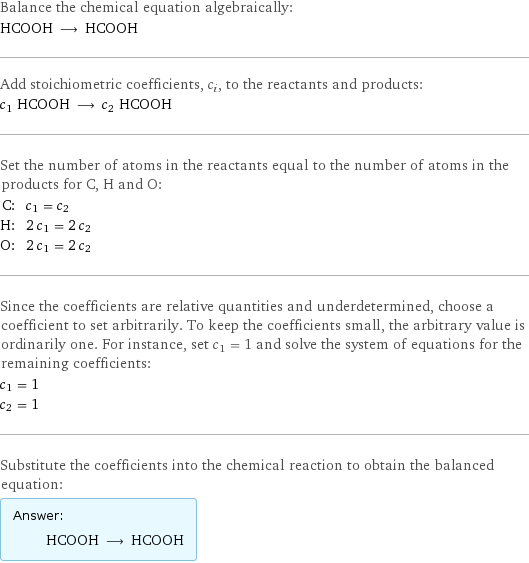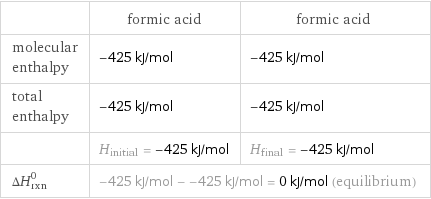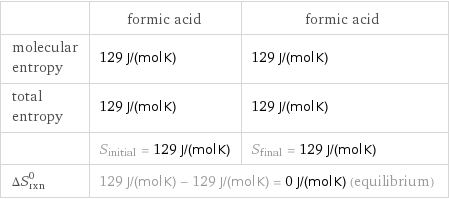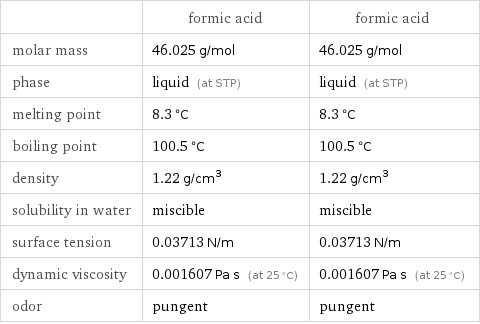Input interpretation

HCOOH formic acid ⟶ HCOOH formic acid
Balanced equation

Balance the chemical equation algebraically: HCOOH ⟶ HCOOH Add stoichiometric coefficients, c_i, to the reactants and products: c_1 HCOOH ⟶ c_2 HCOOH Set the number of atoms in the reactants equal to the number of atoms in the products for C, H and O: C: | c_1 = c_2 H: | 2 c_1 = 2 c_2 O: | 2 c_1 = 2 c_2 Since the coefficients are relative quantities and underdetermined, choose a coefficient to set arbitrarily. To keep the coefficients small, the arbitrary value is ordinarily one. For instance, set c_1 = 1 and solve the system of equations for the remaining coefficients: c_1 = 1 c_2 = 1 Substitute the coefficients into the chemical reaction to obtain the balanced equation: Answer: | | HCOOH ⟶ HCOOH
Structures

⟶
Names

formic acid ⟶ formic acid
Reaction thermodynamics
Enthalpy

| formic acid | formic acid molecular enthalpy | -425 kJ/mol | -425 kJ/mol total enthalpy | -425 kJ/mol | -425 kJ/mol | H_initial = -425 kJ/mol | H_final = -425 kJ/mol ΔH_rxn^0 | -425 kJ/mol - -425 kJ/mol = 0 kJ/mol (equilibrium) |
Gibbs free energy

| formic acid | formic acid molecular free energy | -361.4 kJ/mol | -361.4 kJ/mol total free energy | -361.4 kJ/mol | -361.4 kJ/mol | G_initial = -361.4 kJ/mol | G_final = -361.4 kJ/mol ΔG_rxn^0 | -361.4 kJ/mol - -361.4 kJ/mol = 0 kJ/mol (equilibrium) |
Entropy

| formic acid | formic acid molecular entropy | 129 J/(mol K) | 129 J/(mol K) total entropy | 129 J/(mol K) | 129 J/(mol K) | S_initial = 129 J/(mol K) | S_final = 129 J/(mol K) ΔS_rxn^0 | 129 J/(mol K) - 129 J/(mol K) = 0 J/(mol K) (equilibrium) |
Equilibrium constant
![Construct the equilibrium constant, K, expression for: HCOOH ⟶ HCOOH Plan: • Balance the chemical equation. • Determine the stoichiometric numbers. • Assemble the activity expression for each chemical species. • Use the activity expressions to build the equilibrium constant expression. Write the balanced chemical equation: HCOOH ⟶ HCOOH Assign stoichiometric numbers, ν_i, using the stoichiometric coefficients, c_i, from the balanced chemical equation in the following manner: ν_i = -c_i for reactants and ν_i = c_i for products: chemical species | c_i | ν_i HCOOH | 1 | -1 HCOOH | 1 | 1 Assemble the activity expressions accounting for the state of matter and ν_i: chemical species | c_i | ν_i | activity expression HCOOH | 1 | -1 | ([HCOOH])^(-1) HCOOH | 1 | 1 | [HCOOH] The equilibrium constant symbol in the concentration basis is: K_c Mulitply the activity expressions to arrive at the K_c expression: Answer: | | K_c = ([HCOOH])^(-1) [HCOOH] = ([HCOOH])/([HCOOH])](../image_source/dfe639cc0ed3cd07b10f2fdeeb61a2fd.png)
Construct the equilibrium constant, K, expression for: HCOOH ⟶ HCOOH Plan: • Balance the chemical equation. • Determine the stoichiometric numbers. • Assemble the activity expression for each chemical species. • Use the activity expressions to build the equilibrium constant expression. Write the balanced chemical equation: HCOOH ⟶ HCOOH Assign stoichiometric numbers, ν_i, using the stoichiometric coefficients, c_i, from the balanced chemical equation in the following manner: ν_i = -c_i for reactants and ν_i = c_i for products: chemical species | c_i | ν_i HCOOH | 1 | -1 HCOOH | 1 | 1 Assemble the activity expressions accounting for the state of matter and ν_i: chemical species | c_i | ν_i | activity expression HCOOH | 1 | -1 | ([HCOOH])^(-1) HCOOH | 1 | 1 | [HCOOH] The equilibrium constant symbol in the concentration basis is: K_c Mulitply the activity expressions to arrive at the K_c expression: Answer: | | K_c = ([HCOOH])^(-1) [HCOOH] = ([HCOOH])/([HCOOH])
Rate of reaction
![Construct the rate of reaction expression for: HCOOH ⟶ HCOOH Plan: • Balance the chemical equation. • Determine the stoichiometric numbers. • Assemble the rate term for each chemical species. • Write the rate of reaction expression. Write the balanced chemical equation: HCOOH ⟶ HCOOH Assign stoichiometric numbers, ν_i, using the stoichiometric coefficients, c_i, from the balanced chemical equation in the following manner: ν_i = -c_i for reactants and ν_i = c_i for products: chemical species | c_i | ν_i HCOOH | 1 | -1 HCOOH | 1 | 1 The rate term for each chemical species, B_i, is 1/ν_i(Δ[B_i])/(Δt) where [B_i] is the amount concentration and t is time: chemical species | c_i | ν_i | rate term HCOOH | 1 | -1 | -(Δ[HCOOH])/(Δt) HCOOH | 1 | 1 | (Δ[HCOOH])/(Δt) (for infinitesimal rate of change, replace Δ with d) Set the rate terms equal to each other to arrive at the rate expression: Answer: | | rate = -(Δ[HCOOH])/(Δt) = (Δ[HCOOH])/(Δt) (assuming constant volume and no accumulation of intermediates or side products)](../image_source/906ffc0485938606adb9bb97f3b07d80.png)
Construct the rate of reaction expression for: HCOOH ⟶ HCOOH Plan: • Balance the chemical equation. • Determine the stoichiometric numbers. • Assemble the rate term for each chemical species. • Write the rate of reaction expression. Write the balanced chemical equation: HCOOH ⟶ HCOOH Assign stoichiometric numbers, ν_i, using the stoichiometric coefficients, c_i, from the balanced chemical equation in the following manner: ν_i = -c_i for reactants and ν_i = c_i for products: chemical species | c_i | ν_i HCOOH | 1 | -1 HCOOH | 1 | 1 The rate term for each chemical species, B_i, is 1/ν_i(Δ[B_i])/(Δt) where [B_i] is the amount concentration and t is time: chemical species | c_i | ν_i | rate term HCOOH | 1 | -1 | -(Δ[HCOOH])/(Δt) HCOOH | 1 | 1 | (Δ[HCOOH])/(Δt) (for infinitesimal rate of change, replace Δ with d) Set the rate terms equal to each other to arrive at the rate expression: Answer: | | rate = -(Δ[HCOOH])/(Δt) = (Δ[HCOOH])/(Δt) (assuming constant volume and no accumulation of intermediates or side products)
Chemical names and formulas

| formic acid | formic acid formula | HCOOH | HCOOH Hill formula | CH_2O_2 | CH_2O_2 name | formic acid | formic acid
Substance properties

| formic acid | formic acid molar mass | 46.025 g/mol | 46.025 g/mol phase | liquid (at STP) | liquid (at STP) melting point | 8.3 °C | 8.3 °C boiling point | 100.5 °C | 100.5 °C density | 1.22 g/cm^3 | 1.22 g/cm^3 solubility in water | miscible | miscible surface tension | 0.03713 N/m | 0.03713 N/m dynamic viscosity | 0.001607 Pa s (at 25 °C) | 0.001607 Pa s (at 25 °C) odor | pungent | pungent
Units
